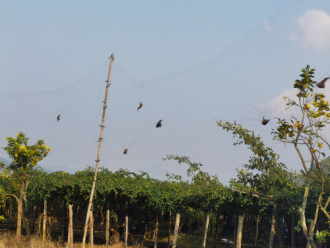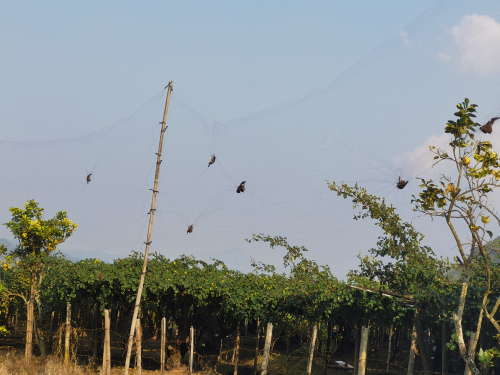News release
From:
Press Releases
Peer-reviewed; observational study; animals
New viruses discovered in bat kidneys in Yunnan province
The viruses, as well as new bacterial species and a new parasite, were discovered in bats inhabiting orchards near villages in southwestern China, raising concerns about transmission to livestock or humans.
Researchers have discovered two new viruses in bats that are closely related to the deadly Nipah and Hendra viruses — pathogens that can cause severe brain inflammation and respiratory disease in humans. The viruses, as well as other new viruses, bacteria, and parasites identified from bat kidneys, were reported this week in the open-access journal PLOS Pathogens by Yun Feng of the Yunnan Institute of Endemic Disease Control and Prevention, China, and colleagues.
Bats are natural reservoirs for a wide range of microorganisms, including many notable pathogens that have been transmitted to humans. However, a full survey of the diverse array of viruses, fungi, bacteria, and parasites that infect bats has been lacking. Most previous studies have focused on bat feces rather than the animals’ organs.
In the new study, researchers looked inside the kidneys of 142 bats from ten species, collected over four years across five areas of Yunnan province, China. Using advanced genetic sequencing, the team found 22 viruses — 20 of them never seen before.
Two of the most concerning were new henipaviruses, the same genus as Nipah and Hendra viruses, which are known for their high fatality rates in humans. The henipaviruses were found in fruit bats living near orchards close to human villages. Since henipaviruses can spread through urine, the study raises concerns about contaminated fruit and the risk of these viruses jumping to humans or livestock.
The research also identified a novel protozoan parasite, tentatively named Klossiella yunnanensis, along with two highly abundant bacterial species, one of which is a newly discovered species — Flavobacterium yunnanensis.
“These findings broaden our understanding of the bat kidney infectome, underscore critical zoonotic threats, and highlight the need for comprehensive, full-spectrum microbial analyses of previously understudied organs to better assess spillover risks from bat populations.,” the authors say.
The authors add: "By analyzing the infectome of bat kidneys collected near village orchards and caves in Yunnan, we uncovered not only the diverse microbes bats carry, but also the first full-length genomes of novel bat-borne henipaviruses closely related to Hendra and Nipah viruses identified in China—raising urgent concerns about the potential for these viruses to spill over into humans or livestock.”
Expert Reaction
These comments have been collated by the Science Media Centre to provide a variety of expert perspectives on this issue. Feel free to use these quotes in your stories. Views expressed are the personal opinions of the experts named. They do not represent the views of the SMC or any other organisation unless specifically stated.
Associate Professor Vinod Balasubramaniam is a Molecular Virologist and the Leader of the Infection and Immunity Research Strength from the Jeffrey Cheah School of Medicine & Health Sciences at Monash University in Malaysia
The recent study published in PLOS Pathogens identified significant new bat-associated viruses in Yunnan province, China. Researchers sequenced kidney tissues from 142 bats across ten species, revealing a diverse range of microbes, including 20 previously unknown viruses. Most notably, two novel henipaviruses, Yunnan bat henipavirus 1 and 2, closely resemble the deadly Hendra and Nipah viruses, with genetic identities of 52-57%.
These viruses are particularly concerning because they were predominantly found in bat kidneys, a site linked to urine production, raising alarm about potential human exposure via contaminated fruits or water (routes implicated in previous outbreaks). Nipah virus, known for mortality rates between 35-75%, and Hendra virus, which has caused fatal human and animal infections in Australia, exemplify the severe threat these newly discovered viruses pose.
Significantly, this research marks the first time full-length henipavirus genomes have been identified in Chinese bats, highlighting Yunnan as a critical region for zoonotic emergence due to its ecological parallels with Nipah-affected areas like Malaysia.
Additionally, the discovery of new bacterial species (Flavobacterium yunnanensis) and protozoan parasites (Klossiella yunnanensis) underscores the complexity of microbial ecosystems within bats, enhancing our understanding of potential zoonotic interactions.
For Australia, with its history of Hendra outbreaks linked to bat populations, the findings hold special relevance. The similarity between Australian rural environments and Yunnan’s orchards near human settlements stresses the urgency of intensified surveillance and biosecurity measures.
Global connectivity means an outbreak in China could swiftly reach Australia, emphasising the need for robust local monitoring strategies, particularly targeting bat kidneys, a novel insight provided by this study.
Take home point: The discovery that kidneys serve as a primary site for viral replication reshapes global surveillance strategies. Newly identified viruses, the closest known relatives to the deadly Nipah and Hendra viruses, underscore significant global health threats. Yunnan's rich biodiversity is critical for advancing pandemic preparedness efforts. For Australia, recommendations include intensifying surveillance of local bat populations, implementing public education campaigns to reduce human-bat interactions, and increasing investments in biosecurity measures. These steps aim to mitigate the risks of future zoonotic disease outbreaks, enhancing national and global resilience against emerging viral threats.
Dr Alison Peel is a veterinarian and wildlife disease ecologist from the Sydney School of Veterinary Science at The University of Sydney
The main significance of this work lies in the discovery of viruses in bats in China that are ‘evolutionary cousins’ to two of the most concerning pathogens in humans – Hendra virus and Nipah virus – which circulate in bats and are highly fatal if they spill over into people.
While one of the new viruses in this study appears to be the closest known relative to these highly fatal viruses, there are some genetic differences in the regions of the virus responsible for binding to and entering cells, so we can’t automatically assume that it can cross over to new species. We have other examples of close evolutionary cousins to Hendra and Nipah that appear not to be of any concern for spillover, so there will need to be some more laboratory studies on these new viruses to determine the actual risk.
Importantly, the bats infected with the Hendra-like virus were captured in fruit orchards, highlighting potential opportunities for contact with humans and domestic species. Our research on Hendra virus spillover in Australia has demonstrated clear links between habitat destruction, loss of natural food, and increased spillover risk – so this may also be the case in China. Rather than focusing on bats as the problem, we’ve also shown evidence that protecting and restoring bat food sources is an effective and sustainable solution. These ecological solutions reduce spillover risk while also supporting healthy bat populations and ecosystems.
Dr Nias Peng is a virologist who has worked on animal viruses.
Bats are natural reservoirs for a wide range of microorganisms, including clinically-important zoonotic pathogens that can infect humans and cause severe disease. Many previous studies have focussed on bat faeces rather than tissue organs when surveying for novel microbes (viruses, bacteria, parasites) harboured by bats.
A recent study published in PLOS Pathogens, which includes collaborators from Australia’s University of Sydney, used advanced genetic sequencing to examine kidney tissues from 142 bats across ten different species. Remarkably, they identified 22 viruses, 20 of which were previously unknown. The study also identified 2 bacterial species, which include a new bacterial species (Flavobacterium yunnanensis) and a protozoan parasite (Klossiella yunnanensis), adding depth to our understanding of the “infectome” — the total microbial community consisting of viruses, bacteria, and parasites — of bat kidneys.
The most noteworthy discovery was two novel henipaviruses — genetically close relatives of Hendra and Nipah, which are known to cause severe respiratory and neurological illnesses in humans and animals, with mortality rates as high as 80%. These findings carry critical implications for public health in Australia and globally.
While the findings are based on bat kidney samples and do not confirm imminent outbreaks, they reveal how much we still don’t know about the microbes bats carry. Those henipaviruses were identified in fruit bats living near orchards close to human settlements near the southern borders of China, highlighting a real risk of transmission through bat urine-contaminated fruits consumed by humans and livestock. With climate change, land use shifts, and global trade, Australia cannot afford to ignore the potential for new zoonotic diseases crossing species barriers, resulting in outbreaks that may spread globally.
Given Australia's history with Hendra virus outbreaks since its emergence in 1994 to cause multiple fatal infections in horses and humans, this underscores the importance of continued vigilance in rural and peri-urban areas close to bat habitats. Strengthening disease surveillance (by including sampling from tissue organs), understanding spillover mechanisms, and educating the public about reducing exposure risks (like ensuring fruits are washed and livestock protected from exposure) could help mitigate potential outbreaks.
The study provides a timely reminder to support ongoing research into emerging infectious diseases and reinforces the importance of comprehensive wildlife disease surveillance efforts to mitigate biosecurity risks and protect public health in Australia.
Professor Tim Mahony is the Director of the Centre for Animal Science and a Professorial Research Fellow in Veterinary Virology at The University of Queensland
This study highlights that we know very little about the viruses that infect bats and those that exist in our world more generally. The technologies and approaches used in this study enabled the authors to identify new viruses more easily compared to conventional virological techniques. The detection of two viruses that are closely related to Hendra virus and Nipah virus is of particular interest. While the Hendra and Nipah viruses are highly lethal to humans, infection is rare, particularly for Hendra virus.
Human infection by Hendra virus requires an amplifying host, horses, with no reports of anyone being infected through contact with bats or their fluids. The situation with Nipah virus is somewhat different, as while an amplifying host can be involved (typically pigs), human infections through contact with saliva from infected bats is a known risk. Whether either of these scenarios, or others, applies to the related viruses identified in this study is impossible to know.
Bats are critical to the health of our ecosystems, playing roles in pollination and seed dispersal. People should not touch or handle bats, contacting the relevant authorities if they see an injured bat or one showing signs of illness. Indeed, that goes for most wildlife, as they may also be carrying viruses or other pathogens that are potentially dangerous to humans.
Multimedia




 Australia; International; NSW
Australia; International; NSW



